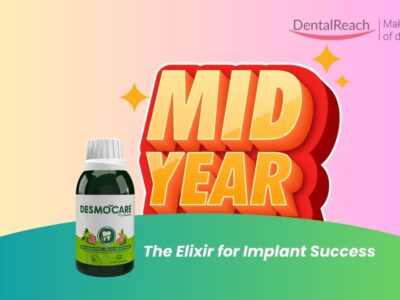Editorial for March 2023 Volume 6, Issue 3
We all heal well with a little bit of help.
Assistance or support at the right time can do wonders for us. Unsurprisingly, nature works the same way. Everything in nature is interdependent in a way that the cycle of life and sustainability keeps going. Sometimes, Man’s intervention has helped diseased plants to be cured and injured trees to live longer, simply by use of ‘grafts’. As everything in nature, Man applied the same principles in healthcare, and ‘grafts’ have been used in medical and dental sciences to help in faster healing and better health. Let us see how!

Grafts in Nature
In horticulture, grafts are used for joining together plant parts by means of tissue regeneration. Grafting is the act of placing a portion of one plant (bud or scion) into or on a stem, root, or branch of another (stock) in such a way that a union will be formed and the partners will continue to grow. (1)
The part of the combination that provides the root is called the stock; the added piece is called the scion. When more than two parts are involved, the middle piece is called the interstock. When the scion consists of a single bud, the process is called budding.

In plants, grafting and budding are the most widely used vegetative propagation methods. Simply put, grafting in nature is the act of joining two plants together.
Plant grafting is used for a variety of purposes (1)
- to repair injured trees
- to produce dwarf trees and shrubs
- to strengthen plants’ resistance to certain diseases
- to retain varietal characteristics
- to adapt varieties to adverse soil or climatic conditions
- to ensure pollination
- to produce multifruited or multiflowered plants
- to propagate certain species (such as hybrid roses) that can be propagated in no other way.

Grafts in Medicine
In medicine, grafting is obtaining healthy skin, bone, or other tissue from one part of the body and using it to replace diseased or injured tissue from another part of the body. Surgeons insert a new piece of tissue in the place where the same type of tissue needs to heal or join.(2)
Types of grafts in medicine:
- Skin Grafts – When skin damage is too big to treat with stitches, grafts can help. The injured skin is removed and replaced with a healthy patch, usually from somewhere else on the body, like an arm or leg. Over days or weeks, it heals together with the surrounding skin. (2) Skin grafting is done in skin damaged due to –
- Burns
- Injuries/accidents/trauma
- Surgery.
- Ligament Grafts – Ligaments are tough bands of tissue that hold bones or cartilage together. But when they tear, they may not heal. Doctors routinely treat ligament tears like torn ACLs (anterior cruciate ligament) in the knee, by grafting on a healthy tendon to replace it.
- Vascular Grafts (like coronary bypass) – If one of the arteries in the heart is blocked or dangerously narrowed, treatment advised is a coronary artery bypass graft. It can be done via two types of grafting:
- Surgeons remove a vein (often from the leg) and attaches it to the artery on either side of the problem area. This is a bypass.
- Surgeons reconnect one end of an artery (usually from the chest) directly to the heart.
Doctors can use similar strategies with blocked or narrowed arteries in other areas of the body
- Bone Grafts – Doctors can treat damaged bone with a graft of healthy bone, usually taken from the pelvic bone. More recently, they use injections of bone marrow instead. Once it’s in place, the bone grows and heals. Bone grafts generally are used in:
- An initial fracture with a big gap that won’t heal without a graft
- A previously treated fracture graft that didn’t heal well
- Diseases of the bone, like osteonecrosis or cancer
- Injuries, trauma, accidents
- Spinal fusion surgery (for an unstable spine)
- Surgically implanted devices, like in total knee replacement, to help promote bone growth around the structure. (3)
- Cosmetic Surgery Grafts – There are many types of these grafts, where the intention is only to increase the esthetic value of the area. Examples include:
- To treat baldness, a surgeon removes tiny sections of the scalp, with hair, from the back of the head and grafts them into bare spots.
- Cosmetic surgeons may also take fat cells from one part of your body and transfer it somewhere else, like in the breasts for augmentation or in the face as part of a facelift.
Grafts in Dentistry
Alveolar ridge defects develop as a result of surgery, trauma, infection, or congenital malformations. In dentistry, just like in medicine, bone grafting replaces missing bone with material from patient′s own body or an artificial/synthetic/natural substitute. These grafts are bioresorbable and have no antigen-antibody reaction. They act as a mineral reservoir which induces new bone formation. Bone grafts have their unique place of importance in clean and quick surgical dentistry. Before knowing its applications in the field, one must know the basics and types of bone graft materials. (4)
Types of grafts in dentistry:
- Endodontic Grafts – Although less known, endodontic surgery uses bone grafting materials more and more frequently these days for bone defects due to large periapical lesions. Bone grafting and guided tissue regeneration are two modern methods that have been developed to treat certain bone abnormalities concerning Endodontics. (5)
- Implant Grafts – There is a need to place dental implants in strategic sites for functional and esthetic success. Implants require sufficient bone volume and biologic quality. Recent advances in biotechnology and materials have provided implant surgeons with access to many bone grafting materials, making implant treatment easier. (6)
- Periodontal Grafts – A variety of surgical procedures can be performed for the treatment of gingival recession, including the subepithelial connective tissue graft. An alternative treatment to eliminate the need for a second surgical area-usually the palate -is to use a graft material, such as the porcine collagen matrix (Mucograft®). (7)
- Extraction grafts – Preservation of the tooth socket is important in the prevention of bone loss, reduction of soft tissue collapse, and maintenance of gingival architecture, which in turn gives better prosthetic outcomes. The most commonly used socket preservation techniques in dentistry include the use of bone graft materials, barrier membranes, and growth factors.(8)
Working with grafts requires a special set of skills. With various available grafts and regenerative techniques, extensive knowledge of the principles, harvesting & healing of these grafts is the cornerstone of successful regeneration.(9)
I hope you enjoyed reading this article and learnt few new things about grafts! If you did, please leave a comment below to let me know!
References
1. Britannica, The Editors of Encyclopaedia. "graft". Encyclopedia Britannica, 11 Feb. 2023, https://www.britannica.com/topic/graft. Accessed 27 March 2023.
2. Adams DC, Ramsey ML. Grafts in dermatologic surgery: review and update on full- and split-thickness skin grafts, free cartilage grafts, and composite grafts. Dermatol Surg. 2005 Aug;31(8 Pt 2):1055-67
3. Oryan, A., Alidadi, S., Moshiri, A. et al. Bone regenerative medicine: classic options, novel strategies, and future directions. J Orthop Surg Res 9, 18 (2014).
4. DentalReach – Leading Dental Magazine – Dentistry Journal, News & Events (March 28, 2023) Bone grafts in surgical dentistry. Retrieved from https://dentalreach.today/bone-grafts-in-surgical-dentistry/
5. DentalReach – Leading Dental Magazine – Dentistry Journal, News & Events (March 28, 2023) Endodontic Grafts: A Comprehensive Guide for Dental Practitioners. Retrieved from https://dentalreach.today/endodontic-grafts-a-comprehensive-guide-for-dental-practitioners/.
6. DentalReach – Leading Dental Magazine – Dentistry Journal, News & Events (March 28, 2023) Bone Substitutes In Implantology: A Review. Retrieved from https://dentalreach.today/bone-substitutes-in-implantology-a-review/.
7. DentalReach – Leading Dental Magazine – Dentistry Journal, News & Events (March 28, 2023) Bone grafts in surgical dentistry. Retrieved from https://dentalreach.today/mucograft-as-an-alternative-treatment-in-the-management-of-multiple-gingival-recessions-a-case-report/
8. DentalReach – Leading Dental Magazine – Dentistry Journal, News & Events (March 28, 2023) Extraction Socket Preservation: When, why, how?. Retrieved from https://dentalreach.today/extraction-socket-preservation-when-why-how/.
9. DentalReach – Leading Dental Magazine – Dentistry Journal, News & Events (March 28, 2023) Principles, Harvesting & Healing of Bone Grafts in Dental Implant Cases. Retrieved from https://dentalreach.today/principles-harvesting-healing-of-bone-grafts-in-dental-implant-cases/.




















Comments